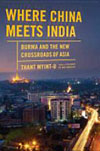 With Myanmar occupying international headlines over the recent months, Thant Myint-U’s new book provides a valuable historical and geographical compass to better understand the context of the latest developments in a country now emerging from military rule.
With Myanmar occupying international headlines over the recent months, Thant Myint-U’s new book provides a valuable historical and geographical compass to better understand the context of the latest developments in a country now emerging from military rule.
Until recently, Myanmar (the author refers to it as Burma, its former name) was a relative hinterland economically, geopolitically, the occasional report about Myanmar’s democratic leader Aung San Suu Kyi notwithstanding. The developments which Thant Myint-U describes in his book, however, predate the recent reform surge. He describes a country that is being propelled into a position of growing strategic opportunities and relevance almost in spite of itself, and with an uncertain trajectory for the future.
Thant’s book is a collage of travelogue entries, historical accounts, and bits of analysis. His descriptions of the landscapes, people, and cities he visited in Myanmar as well as bordering China and India are lively and colorful.
Complementing every chapter, Thant goes back many centuries and sketches out the historical evolution and key events which took place in the respective region. Be it the role of the various hill peoples in Myanmar during the British colonial period and their decades long war with the central government (which continues until today) or Muslim influence in Western China and the subsequent spread and dominance of the Han Chinese majority, Thant provides meticulous, detailed, and very readable historical accounts.
The historical background frames the key arguments Thant is making about Myanmar’s present and future role. He highlights how Myanmar is located between and connects the two geopolitical and economic giants of Asia, India and China. Having been separated by jungle and the Himalayas for millennia, these two civilizations now interact directly with one another in Myanmar. This is the central premise of Thant’s book.
Myanmar is not only rich in natural resources, but it also provides important trade routes connecting the region. Thant emphasizes in particular the role of ever booming and energy thirsty China. China is building roads, pipelines and hydroelectric dams in Myanmar. This will open up an alternative access to the sea for the shipment of goods as well as fossil fuels and provide much needed electricity for China’s hinterland.
At the end of the last chapter, Thant describes two big scenarios, one in which sanctions remain in place, Western influence is near zero, and China has unhindered access to the markets and resources of its weak neighbor. This scenario anticipates continued underdevelopment, total irrelevance of the West, continued conflict in Myanmar, and even long-term problems for China due to growing anti-Chinese sentiment in Myanmar. In the more optimistic scenario, Myanmar becomes a bridge between cultures, a hub for economic activity and free trade, and a haven of stability.
Compelling though they are, Thant devotes just one page to these scenarios. Given the intellectual depth of the rest of the book, this parts leaves the reader wanting for more.




